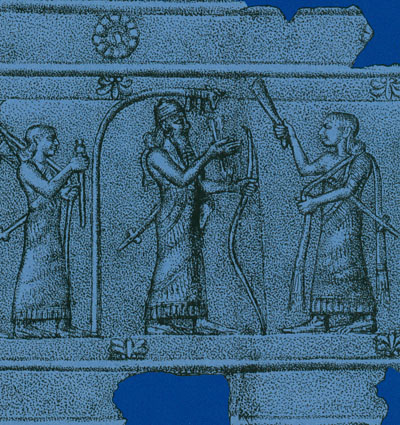
J.E. CURTIS & N. TALLIS (ed.). . The Balawat Gates of Ashurnasirpal II. xx+264 pages, 62 b&w & colour plates, 102 figures, 10 tables, 1 diagram. 2008. London: British Museum Press; 978-0-7141-1166-7 hardback £50.

J.E. CURTIS & N. TALLIS (ed.). . The Balawat Gates of Ashurnasirpal II. xx+264 pages, 62 b&w & colour plates, 102 figures, 10 tables, 1 diagram. 2008. London: British Museum Press; 978-0-7141-1166-7 hardback £50.

Review by Frances Reynolds
Oriental Institute, University of Oxford, UK
(Email: frances.reynolds@orinst.ox.ac.uk)
This important and generously illustrated volume publishes in full for the first time two pairs of Neo-Assyrian wooden gates decorated with figurative and inscribed bronze bands from the reign of Ashurnasirpal II (883–859 BCE). The book opens up unparalleled access to these rich primary sources for Assyrian history, royal ideology, art and material culture.
John Curtis and Nigel Tallis of the Department of the Middle East at the British Museum edited the volume with contributions by Richard Barnett, Leri Davies, Irving Finkel, Marjorie Howard, Edmund Sollberger and Christopher Walker. This wealth of expertise results in a wonderful resource and shows the time-scale and scope of the British Museum's work on these gates. The current editors felt that it was imperative to publish them in full as soon as possible and to put important, basic material in the public domain.
Both pairs of gates were discovered at the small Assyrian site of Imgur-Enlil, modern Balawat, in northern Iraq. The site lies 16km north-east of Kalhu, modern Nimrud, which Ashurnasirpal remodelled as a new Assyrian imperial capital. One pair of gates, about 4m high, was discovered in a palace of Ashurnasirpal in 1878 by Hormuzd Rassam and is now on display in the British Museum. The other pair was found in a temple of the god Mamu in 1956 during a British School of Archaeology in Iraq excavation directed by Max Mallowan. After conservation and study at the British Museum, the temple gate bands were displayed in the Mosul Museum in Iraq. Tragically, large parts of these bands were looted in April 2003 and are lost. Thus, the only full record of the appearance of the temple bands is found in this book.
Ashurnasirpal's son and successor, Shalmaneser III, erected a similar pair of wooden and bronze palace gates at Imgur-Enlil. These were also discovered by Hormuzd Rassam in 1878 and can be seen in the British Museum, accompanied by a dramatic reconstruction. Shalmaneser's gates have been well known through publication since 1902 and this book means that his father's gates can now be similarly appreciated.
The available evidence about Ashurnasirpal's gates is thoroughly presented by the editors, using both text and illustration. Eight bands chased and embossed with figurative scenes and cuneiform inscriptions decorated each gate leaf and all 32 bands are illustrated and published in detail. The royal themes of warfare, receiving captives and tribute, and hunting lions and bulls were employed. The bands were arranged in a decorative scheme and the diminishing diameter of the gate posts, originally tree trunks, remains diagnostic. Bronze edging strips were also inscribed.
After Richard Barnett's original introduction in Chapter 1, John Curtis gives a very useful summary of the Balawat excavations and discoveries in Chapter 2. The textual heart of the book is a pair of chapters, Chapter 3 on the palace gates and Chapter 4 on the temple gates. Each chapter is packed with invaluable material from a range of contributors as follows: introduction; technical description or excavation; arrangement of the bands and content matter; description of the gates; and inscribed edging strips.
A comparison of the two sets of bands by John Curtis and Nigel Tallis in Chapter 5 significantly reveals that hunting scenes and files of captives occur only on the palace gates. John Curtis investigates bronze gate overlay in Mesopotamia in Chapter 6 as a final contextual study.
Five appendices add rich documentary material, drawing on letters of Hormuzd Rassam and others, registered finds and samples, as well as inscribed material, from the British School of Archaeology in Iraq excavations, and Ashurnasirpal's stone inscriptions from the site.
Valuable though the chapters and appendices are, much of the book's impact lies in its illustrations. Justifiably occupying more than half the volume, they give a very thorough visual coverage of both pairs of gates. The four colour plates and 161 monochrome figures, plates and diagrams include many excellent photographs and drawings that are published for the first time. Particular gratitude is owed to Marjorie Howard who prepared the drawings of both pairs of gates.
From excavation to full publication 130 years have elapsed for Ashurnasirpal's palace gates and 52 years for those from the Mamu Temple, so this book is a very welcome corrective. Taking a holistic approach, the editors present a wide range of evidence with expertise, thoroughness, and clarity. Given Iraq's recent turbulent history, including the looting of large parts of the temple bands, it is especially important that these gates are finally published in full.
